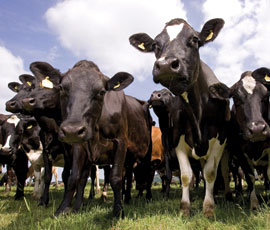Dairy farmers exit rate set to rise, report warns

A triple whammy of milk price cuts, rising costs and wet weather will force dairy farmers to quit the sector, a report warns.
The average dairy farmer is set to lose £7,500 a month this autumn, suggests the Kite Consulting analysis.
“The exit rate for those farmers who are subjected to the lowest price cuts and the best dairying conditions will be between 3% and 5% because of low confidence and cashflow problems,” it says.
But a 1.5p/litre feed price increase could easily double this exit rate.
“The desperation of those farmers facing the worst milk price cuts and who have seen the worst of the weather is such that their exit rates could easily be 10%, with their milk output dropping by the same degree or more.
“Once the 1.5p/litre feed price increase takes effect then exit rates could easily be at record levels – perhaps in the mid-teens.”
Wet weather and higher feed costs mean the average farmer is already £3,600 a month worse off than in April, when milk cost 28.8p/litre to produce, says the analysis.
When price cuts, due on 1 August, are taken into account, the monthly deficit for the average farmer increases first to £6,500 and then to £7,500 as costs rise further.
Net costs of production could increase to more than 31p/litre and with no allowances for investment, the study suggests.
Losses could accrue to more than 6.5p/litre for the average producer, it says.
The analysis was prepared by Chris Flint and Edward Lott of Kite Consulting.
It is based on Kite’s costings service, which assesses the average performance and production costs of hundreds of different dairy farmers across the UK.
The study looks at a typical farmer producing and supplying 1.4m litres of milk a year into the liquid milk market not on a “cost of production” contract.
It assumes a 4p/litre cut in milk price by August 2012, a 1.5p/litre increase in feed costs and a 1p/litre rise in general costs.
“The scenario illustrated is taking the current worst-case scenario in terms of milk price reductions and our estimate of the effect of rapidly rising feed prices on the average producer,” it says.
“Some producers could face even higher cost rises due to reliance on particular feeds, such as soya. For others, the rises could be lower if they were lucky enough to lock into lower prices last spring.”
The analysis also factors in the impact of the wet summer.
“Even if it were to improve in the coming days, the effects are now locked in, with winter feed quality reduced, and higher costs from housing stock through much of the normal grazing season.
“The effect will also be seen through lower productivity this winter, concentrating the fixed costs of the business over fewer litres of milk produced.”
The implications for milk output are obvious, says the study.
“Unless the situation changes, 2012-13 is likely to be the lowest milk production year on record.”
